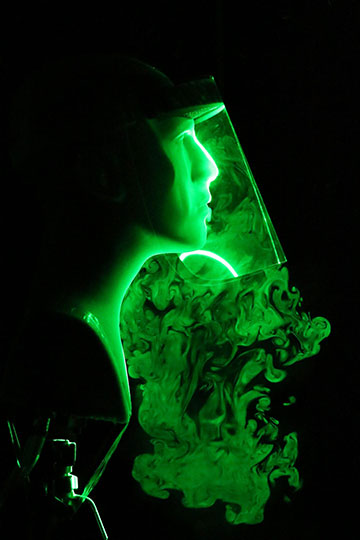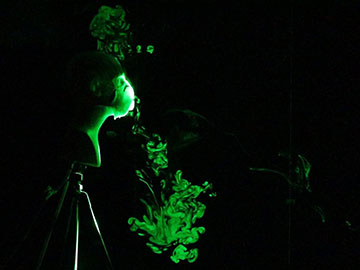
Although face shields block the initial forward motion of the jet, the expelled droplets move around the visor and spread out depending on light ambient disturbances. [Image: Florida Atlantic University's College of Engineering and Computer Science]
To reduce the spread of COVID-19, the U.S. Centers for Disease Control and Prevention (CDC) recommends that people wear masks in public settings. But what kind of masks? The pandemic has seen an explosion of all different types of masks for sale, including surgical masks, masks with valves, cloth masks and others.
Previously, researchers from Florida Atlantic University, USA, used a laser-based visualization tool to demonstrate the effectiveness of cloth masks, finding that both the material and construction techniques matter (Phys. Fluids, doi: 10.1063/5.0016018). A new study from the same group reveals that masks with valves and face shields—options deemed by some as more comfortable to wear—fail to stop the spread of aerosol-sized droplets (Phys. Fluids, doi: 10.1063/5.0022968).
Simulated coughs and sneezes
The CDC states that masks with exhalation valves or vents should not be worn, since air is allowed to flow out of the vent unimpeded, and an infected person wearing one of these masks could easily spread COVID-19 to others. The federal agency also discourages the use of face shields as a sole means of source control, suggesting they should instead be worn only in addition to a mask.
Manhar Dhanak and his colleagues noticed broad variations in recommendations made by states and counties across the U.S., with some allowing the use of face shields as alternatives to masks. They decided to create an experimental setup that could visualize the impact of different face coverings on droplet dispersal during a simulated cough or sneeze.
“We wanted to emulate a cough in the laboratory using a manikin and pumped air plus droplets to see if we can demonstrate how the respiratory jet travels,” said Dhanak, professor and department chair of ocean and mechanical engineering at Florida Atlantic University. “We visualized this with a laser sheet, a very powerful technique to observe the spatial and temporal development of the ejected flow.”
Not as effective

The researchers found that the exhalation port on this N-95 rated face mask with exhalation valves significantly reduced the mask’s effectiveness. [Image: Florida Atlantic University's College of Engineering and Computer Science]
The experimental setup consisted of a hollow manikin head with padding inside to mimic the shape and volume of the nasal and buccal cavities in an adult. A pressure impulse is delivered with a manual air pump, which causes aerosolized microscopic droplets of distilled water and glycerin to eject through the mouth. The droplets are comparable in size to the smallest droplets expelled in a cough jet (approximately 1 to 10 microns in diameter).
For qualitative visualization, horizontal and vertical laser sheets were generated from off-the-shelf green laser pointers. The researchers used a thin cylindrical rod made of borosilicate glass to convert the laser beam into a sheet. The droplets diffract the light from the laser sheets, acting as tracer particles that reveal a two-dimensional cross section of the turbulent jet.
Their results suggest that both face shields and vented masks may not be as effective as regular face masks in restricting the spread of aerosolized droplets. As expected, the exhalation vent allows a large number of droplets to pass through the mask unfiltered. Although the jet is deflected downward due to the angle of the vent, the droplets eventually disperse over a large area. Similarly, a face shield initially blocks the expelled droplets, but they remain suspended beneath the bottom opening of the shield before rising upward after a few seconds.
“In both cases, it helps to stop the direct projection of a cough onto somebody in front of you,” Dhanak said. “They might be good for self-protection, but in terms of protecting other people, they only do so in the short term. If the encounter between an infected person and a susceptible person is prolonged, the droplets that linger will spread and increase the risk of infection.”
